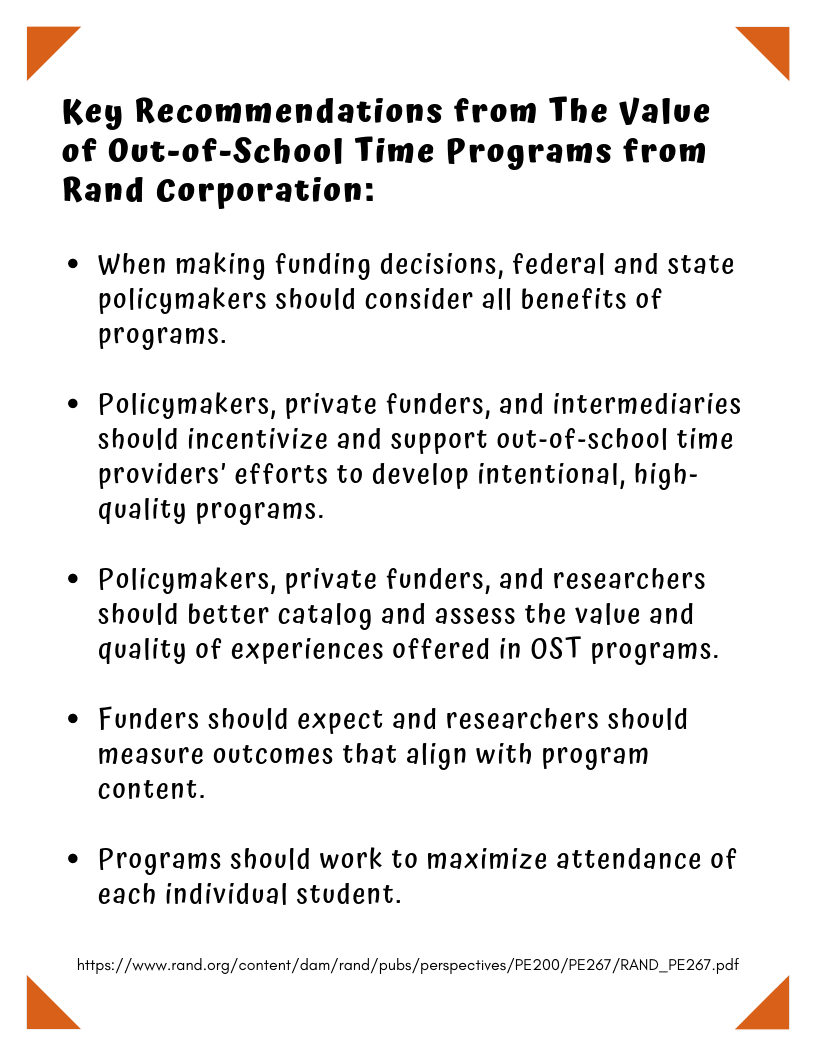Original Posting 12.09.19
For many people, school is a significant part of life. The memories of school experiences are powerful and rate right up there with family memories in terms of importance. The time spent in school is foundational to whom you become. There is another environment that is foundational for school-age youth as well – where time is spent when not in school. That time is referred to as Out-of-School Time or OST. It can be after-school or during school breaks and summer. Where did you spend your time when you weren’t in school? I’m sure you have lots of memories.
"Over 10 million US children head to after school programs when the school day ends." (cdc.gov)
As I reflect on my own OST experiences, for example, Girl Scouts, one common theme is how much I learned from them, increased my confidence and grew – from developing relationships to learning new skills to exploring new locations. Especially when the experience was difficult, the lessons learned stuck with me. And in a different way than a school lesson.
Today’s supervised OST programs include a rich variety of options. Some options are very helpful and developmentally supportive, while others are neutral or some can even be detrimental. So the quality and effectiveness of a program are essential. Kids appreciate good ones. From the Wallace Foundation Knowledge Center Finding One: What Kids Do When They’re Not in School - All Work and No Play?, “Despite the initial attraction of taking it easy after class, the vast majority of youngsters say that organized, structured out-of-school activities are enormously important to them.”
For those of us whose life mission is to support the development of children, we continually explore ways we can support best practices, including in OST programs. According to the Centers for Disease Control and Prevention (CDC), a “Whole Child” approach to OST supports the overall development and wellness of a child, breaks down the silos of education, health, and human services, and includes physical activity and nutrition. This cross-domain, collaborative approach has been shown to reduce disparities and increase the probability of a successful life.
It is important to understand how “content” and “dosage” contribute to the primary and secondary outcomes of an OST program. High-quality OST programs have a stated program focus, such as academic, a specific skill, or general quality care. The “dosage” or frequency with which the child attends the program affects their development from the program. Staff engagement and the environment are also crucial components of developmental success.
So at COMET, we make sure that our system supports best-practice, evidence-based data collection for children. Tracking the content delivered, the child’s activity attendance, and performing primary and secondary outcome assessments (pre/post program delivery) are key to being able to quantify the effectiveness of an OST program. The best programs integrate this data collection as a part of program delivery so that child-centric information is readily available to meet funding requirements and support program evaluation and return on investment calculations.
I’ll bet if you have taken a moment to reflect on your out-of-school time memories, from your best experiences, you likely have childhood friendships and fond role models in your program leaders. Moreover, the activities you attended more frequently have affected you more. So I’ll also bet that the programs whose content effectively developed a talent or strength have impacts on who you are today.

Written by: Diane Trentini, COMET VP of Marketing & Sales, Data Protection Officer
